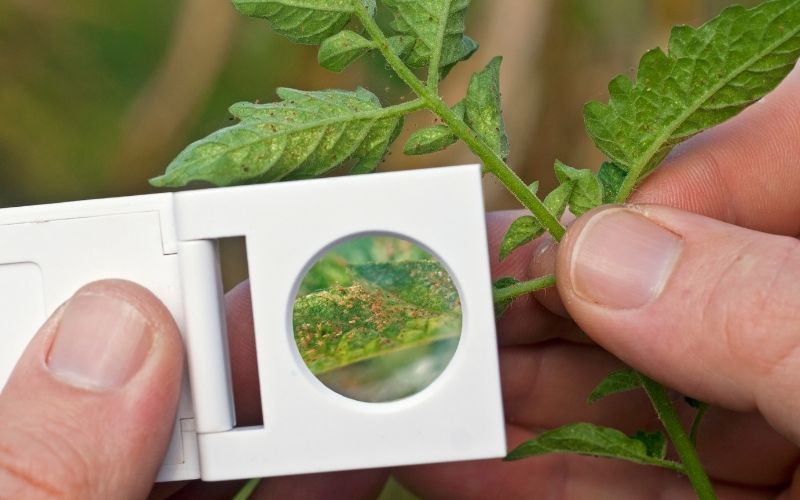It can be tricky to notice that spider mites are damaging your plants until a large part of the plant is affected, even after you have closely inspected your plant. This is especially true if you are a new gardener who has never seen spider mites on plants before and is not familiar with what the damage looks like. Damaged caused by spider mites can look a lot like the plant drying out or a fungal or bacterial infection.
Spider mites are microscopic and barely visible because they are only about 0.5 mm long. Adult spider mites are usually yellowish or reddish colored. They look like very tiny ticks and are related to spiders, scorpions, and as you might have guessed, ticks. Spider mites can be seen on both sides of leaves but prefer to feed and stay on the underside of leaves.
Spider mites can feed on almost all types of vegetable plants and other types of plants. They can severely damage plants by disfiguring and damaging the ability of leaves, flowers, and fruits to function properly. This damage makes the plant less productive and will eventually kill the plant if nothing is done to control the damage.
Spider mites will damage all green leaves, including young leaves. Once they run out of leaves to feed on and they may move onto vegetables. Their feeding behavior on vegetables causes a similar spotting and scarring pattern. They can also damage flowers, giving them a bruised look and stopping the plant from properly producing any more fruiting vegetables.
The first step in controlling and getting rid of spider mites from your vegetable plants is to identify the damage done by them as early as possible. There are a few tell-tale signs of the presence of spider mites that you should look for when you check your plants.
- A spotted yellowish-white pattern on leaves
The first and most obvious sign is a spotted yellowish-white pattern on leaves, which will eventually turn brown. Spider mites create this pattern as they pierce leaves with their mouth-parts and suck out chlorophyll, the green pigment in plants.
The damage is visible close to the veins of the leaves, but the veins themselves won’t be damaged. The yellowing of the leaves due to damage caused by spider mites is quite different from the yellowing seen in nutrient deficiencies. The color doesn’t appear to drain off but rather shows a pixelated pattern when damaged by spider mites.

- Translucent eggs on the underside of the affected leaves
The next tell-tale sign is the tiny round and translucent eggs laid by adult female spider mites that can be seen on the undersides of infected leaves. The eggs are usually laid under the webbing for extra protection and each egg is separate from the others.
When temperatures reach 25-30°C, which is the most suitable temperature for spider mites, their eggs can hatch in just 5 days. An immature stage emerges from the egg and undergoes a few changes before it develops into an adult. Spider mites at these immature stages look similar to the adult stage, except that they are less mobile.

- Webbing around leaves
The name “spider” refers to the silk-like web-spinning ability of spider mites. Once plants have undergone considerable damage, the webs that they create are sometimes more easily visible than the spider mites themselves. Spider mites can even be seen walking on these webs.
Spider mites use their webs for protection from predators, wind, and rain. Thick webbing can even protect spider mites from chemical pesticides, making chemical pesticides useless for their control.

Related Article:
How do you get rid of spider mites on vegetable plants?


